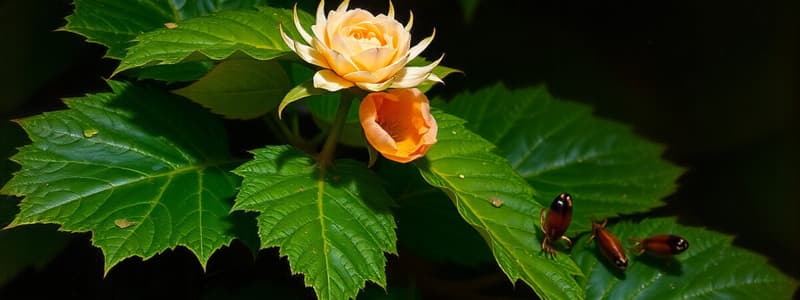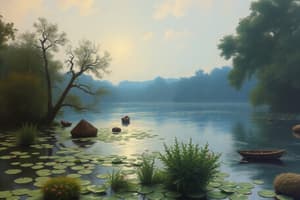Podcast
Questions and Answers
What is the primary function of xylem in plants?
What is the primary function of xylem in plants?
- Providing structural support
- Transporting food
- Transporting water (correct)
- Storing nutrients
Water moves from an area of high concentration to an area of low concentration.
Water moves from an area of high concentration to an area of low concentration.
True (A)
What is the primary difference between mechanical and chemical digestion?
What is the primary difference between mechanical and chemical digestion?
Mechanical digestion involves the physical breakdown of food using structures like teeth and muscle contractions in the stomach. Chemical digestion involves the breakdown of food molecules through enzymatic reactions.
Pepsin, an enzyme found in gastric juice, plays a crucial role in the breakdown of ______.
Pepsin, an enzyme found in gastric juice, plays a crucial role in the breakdown of ______.
Match the following complex molecules with their corresponding building blocks:
Match the following complex molecules with their corresponding building blocks:
Villi are finger-like projections that increase the surface area of the small intestine for enhanced absorption.
Villi are finger-like projections that increase the surface area of the small intestine for enhanced absorption.
Explain what happens to the Bromothymol Blue solution when you exhale into it. What does the change in color indicate?
Explain what happens to the Bromothymol Blue solution when you exhale into it. What does the change in color indicate?
What is the primary function of the diaphragm in breathing?
What is the primary function of the diaphragm in breathing?
What type of blood vessel carries blood away from the heart?
What type of blood vessel carries blood away from the heart?
Identify two locations in the body where gas exchange occurs. What type of blood vessel is involved in this exchange?
Identify two locations in the body where gas exchange occurs. What type of blood vessel is involved in this exchange?
What is the primary function of platelets?
What is the primary function of platelets?
The liver produces urea as a waste product from ammonia.
The liver produces urea as a waste product from ammonia.
What are the three main sections of the brain?
What are the three main sections of the brain?
A _____ is a nerve cell that transmits signals in the nervous system.
A _____ is a nerve cell that transmits signals in the nervous system.
Match the following respiratory conditions with their definitions:
Match the following respiratory conditions with their definitions:
Which of the following is NOT one of the six characteristics of living things?
Which of the following is NOT one of the six characteristics of living things?
The liver is the largest organ in the human body.
The liver is the largest organ in the human body.
What is the process called when particles move from high concentration to low concentration?
What is the process called when particles move from high concentration to low concentration?
The __________ is the organ system that includes the heart and blood vessels.
The __________ is the organ system that includes the heart and blood vessels.
Match the following organisms with how they move:
Match the following organisms with how they move:
What defines a structural adaptation?
What defines a structural adaptation?
Unicellular organisms have multiple cells.
Unicellular organisms have multiple cells.
Name a structure and its function in an organism.
Name a structure and its function in an organism.
Flashcards
Characteristics of Living Things
Characteristics of Living Things
Six features that define living organisms, including made of cells and need for energy.
Growth in Organisms
Growth in Organisms
An increase in the number of cells in an organism, known as growth.
Structure and Function
Structure and Function
The relationship where the structure of an object determines its function.
Structural Adaptation
Structural Adaptation
Signup and view all the flashcards
Largest Organ
Largest Organ
Signup and view all the flashcards
Gas Exchange Structures
Gas Exchange Structures
Signup and view all the flashcards
Diffusion
Diffusion
Signup and view all the flashcards
Osmosis
Osmosis
Signup and view all the flashcards
Function of Platelets
Function of Platelets
Signup and view all the flashcards
Urea
Urea
Signup and view all the flashcards
Nephron Function
Nephron Function
Signup and view all the flashcards
Types of Neurons
Types of Neurons
Signup and view all the flashcards
Sections of the Brain
Sections of the Brain
Signup and view all the flashcards
Xylem
Xylem
Signup and view all the flashcards
Phloem
Phloem
Signup and view all the flashcards
Mechanical Digestion
Mechanical Digestion
Signup and view all the flashcards
Chemical Digestion
Chemical Digestion
Signup and view all the flashcards
Gastric Juice Components
Gastric Juice Components
Signup and view all the flashcards
Villi
Villi
Signup and view all the flashcards
Arteries vs. Veins
Arteries vs. Veins
Signup and view all the flashcards
Gas Exchange Locations
Gas Exchange Locations
Signup and view all the flashcards
Study Notes
Living Things - 6 Characteristics
- Made of cells: All living things are composed of cells
- Need energy: Living things require energy for their functions
- Grow and develop: Living things increase in size and complexity
- Reproduce: Living things create new organisms
- Respond to the environment: Living things react to stimuli from their surroundings
- Adaptations: Living things have special features to survive in their environment
Structure and Function
- Structure determines function: The shape of something dictates what it can do
- Example: The shape of a bird's wing allows it to fly
Structural Adaptation
- A change in a species structure to help it survive
- Example: various answers. (Provided context requires specific examples)
Body Organs
- Lungs are the largest organ in the body
- Skin is the second largest organ in the body
Scientific Drawings
- Diagrams should be labeled.
Cells, Tissues, Organs and Organ Systems
- Similar cells create tissues
- Different tissues create organs
- Different organs create organ systems
- Example: Muscle cells make muscle tissue, various tissues combine to form complex organs like the heart. The heart, arteries, capillaries, and veins all work together in the circulatory system.
Unicellular vs Multicellular
- Unicellular organisms consist of one cell
- Multicellular organisms are made of many cells
Cell Movement
- Amoeba move using pseudopods
- Paramecium move using cilia
Diffusion and Osmosis
- Diffusion: Movement of particles from high to low concentration
- Osmosis: Diffusion of water through a membrane
Water Movement
- Water moves from a high concentration to a low concentration across a membrane
- Explanation: Water moves across the selectively permeable membrane to equalize the concentration of water on both sides
Xylem and Phloem
- Both transport tissues in plants
- Xylem transports water
- Phloem transports food
Digestion
- Mechanical digestion: Physical breakdown (e.g., chewing)
- Chemical digestion: Chemical breakdown (e.g., enzymes)
- Components of gastric juice: HCl, mucus, enzymes (pepsin), water
- Villi: Small projections increasing the surface area of the small intestine for nutrient absorption
Complex Molecule Breakdown
- Complex carbohydrates (starch) break down into sugar
- Lipids (fats) break down into fatty acids
- Proteins break down into amino acids
- Vitamins and minerals remain the same at the molecular level
Breathing and Exhalation
- Exhaled air has carbon dioxide
- Diaphragm acts as a muscle to pump air in and out of the lungs
Body Systems
- Muscles and Organs
- Senses
Heart Anatomy and Function
- Blood vessels
- Arteries carry blood away from heart,(thicker, higher pressure)
- Veins carry blood to heart (thinner, lower pressure, valves)
- Capillaries are where the exchange of gases and nutrients happens between blood and tissues. They are extremely thin and connect arteries to veins.
- Locations of gas exchange in the body occur in the capillaries and the alveoli of the lungs.
Excretion
- Excretion removes waste from the body
- Urea is a waste product made by the liver
- The kidneys are responsible for filtering blood and producing urine
- The Nephron is the working unit of the kidney
Nervous System
- CNS (Central Nervous System): Brain and spinal cord
- PNS (Peripheral Nervous System): Cranial and spinal nerves
- Types of neurons: Motor (sends signals to muscles/organs), Sensory (sends signals from senses to CNS), Interneurons (responsible for thinking/processing information)
- Cranial and Spinal Nerves are part of the Peripheral Nervous System (PNS): True
Brain Sections
- Cerebrum (thoughts)
- Cerebellum (balance)
- Medulla (heart rate)
Vaccines
- Vaccines build immunity
- Edward Jenner is credited with developing vaccines
Respiratory Conditions
- Asthma
- Bronchitis
- Emphysema
- Atherosclerosis
Lung Cancer
- Cancer of the lungs
Studying That Suits You
Use AI to generate personalized quizzes and flashcards to suit your learning preferences.




